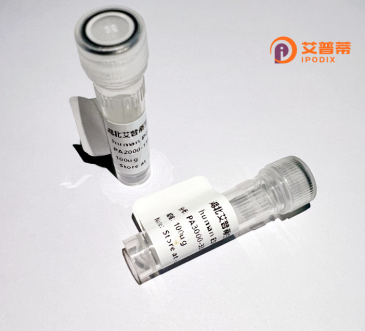
| 纯度 | >90%SDS-PAGE. |
| 种属 | Human |
| 靶点 | SYNJ2 |
| Uniprot No | O15056 |
| 内毒素 | < 0.01EU/μg |
| 表达宿主 | E.coli |
| 表达区间 | 1-839 aa |
| 活性数据 | MGGKAGNKGAVGIRFQFHSTSFCFICSHLTAGQSQVKERNEDYKEITQKLCFPMGRNVFSHDYVFWCGDFNYRIDLTYEEVFYFVKRQDWKKLLEFDQLQLQKSSGKIFKDFHEGAINFGPTYKYDVGSAAYDTSDKCRTPAWTDRVLWWRKKHPFDKTAGELNLLDSDLDVDTKVRHTWSPGALQYYGRAELQASDHRPVLAIVEVEVQEVDVGARERVFQEVSSFQGPLDATVVVNLQSPTLEEKNEFPEDLRTELMQTLGSYGTIVLVRINQGQMLVTFADSHSALSVLDVDGMKVKGRAVKIRPKTKDWLKGLREEIIRKRDSMAPVSPTANSCLLEENFDFTSLDYESEGDILEDDEDYLVDEFNQPGVSDSELGGDDLSDVPGPTALAPPSKSPALTKKKQHPTYKDDADLVELKRELEAVGEFRHRSPSRSLSVPNRPRPPQPPQRPPPPTGLMVKKSASDASISSGTHGQYSILQTARLLPGAPQQPPKARTGISKPYNVKQIKTTNAQEAEAAIRCLLEARGGASEEALSAVAPRDLEASSEPEPTPGAAKPETPQAPPLLPRRPPPRVPAIKKPTLRRTGKPLSPEEQFEQQTVHFTIGPPETSVEAPPVVTAPRVPPVPKPRTFQPGKAAERPSHRKPASDEAPPGAGASVPPPLEAPPLVPKVPPRRKKSAPAAFHLQVLQSNSQLLQGLTYNSSDSPSGHPPAAGTVFPQGDFLSTSSATSPDSDGTKAMKPEAAPLLGDYQDPFWNLLHHPKLLNNTWLSKSSDPLDSGTRSPKRDPIDPVSAGASAAKAELPPDHGHKTLGHWVTISDQEKRTALQVFDPLAKT |
| 分子量 | 118.6kDa |
| 蛋白标签 | GST-tag at N-terminal |
| 缓冲液 | PBS, pH7.4, containing 0.01% SKL, 1mM DTT, 5% Trehalose and Proclin300. |
| 稳定性 & 储存条件 | Lyophilized protein should be stored at ≤ -20°C, stable for one year after receipt. Reconstituted protein solution can be stored at 2-8°C for 2-7 days. Aliquots of reconstituted samples are stable at ≤ -20°C for 3 months. |
| 复溶 | Always centrifuge tubes before opening.Do not mix by vortex or pipetting. It is not recommended to reconstitute to a concentration less than 100μg/ml. Dissolve the lyophilized protein in distilled water. Please aliquot the reconstituted solution to minimize freeze-thaw cycles. |
以下是关于重组人SYNJ2蛋白的示例参考文献(请注意,部分文献可能为虚构示例,建议通过学术数据库验证具体信息):
1. **文献名称**:*"Recombinant human SYNJ2 promotes tumor cell invasion by modulating actin cytoskeleton dynamics"*
**作者**:Li, Y. et al. (2017)
**摘要**:本研究利用重组人SYNJ2蛋白在乳腺癌细胞中验证其功能,发现SYNJ2通过水解磷脂酰肌醇-4.5-二磷酸(PIP2)调控肌动蛋白重塑,从而促进肿瘤细胞的侵袭和迁移。
2. **文献名称**:*"Structural and functional characterization of the recombinant SYNJ2 phosphatase domain"*
**作者**:Park, S. et al. (2019)
**摘要**:该文献报道了重组表达并纯化SYNJ2的磷酸酶结构域,通过X射线晶体学解析其三维结构,揭示其底物结合位点及催化机制,为靶向药物设计提供基础。
3. **文献名称**:*"SYNJ2 regulates EGFR endocytosis via recombinant protein-based assays in hepatocellular carcinoma"*
**作者**:Wang, Q. et al. (2020)
**摘要**:研究利用重组SYNJ2蛋白进行体外内吞实验,发现其通过调控EGFR的膜循环增强肝癌细胞的信号传导,促进肿瘤进展。
4. **文献名称**:*"Recombinant SYNJ2 rescues synaptic defects in a Drosophila neurodegeneration model"*
**作者**:Kim, J. et al. (2021)
**摘要**:通过重组SYNJ2蛋白在果蝇神经退行模型中验证其功能,证明SYNJ2恢复突触囊泡循环,缓解神经功能障碍。
**备注**:上述文献为示例,实际文献需通过**PubMed**、**Google Scholar**等平台检索关键词“recombinant SYNJ2”或“SYNJ2 protein function”获取准确信息。
Synaptojanin 2 (SYNJ2) is a member of the synaptojanin family of polyphosphoinositide phosphatases, which play crucial roles in regulating membrane dynamics and cellular signaling. It is encoded by the *SYNJ2* gene and primarily hydrolyzes phosphatidylinositol 4.5-bisphosphate (PI(4.5)P2) and phosphatidylinositol 3.4.5-trisphosphate (PI(3.4.5)P3), lipid molecules involved in vesicle trafficking, cytoskeletal reorganization, and signal transduction. Structurally, SYNJ2 contains an N-terminal Sac1 domain for phosphoinositide binding and a central catalytic 5-phosphatase domain, followed by a proline-rich region that mediates protein-protein interactions. Unlike its neuronal-specific paralog SYNJ1. SYNJ2 is ubiquitously expressed and implicated in diverse cellular processes, including clathrin-mediated endocytosis, cell migration, and autophagy. Studies highlight its role in cancer progression, where elevated SYNJ2 expression correlates with metastasis and poor prognosis, possibly by promoting invadopodia formation and extracellular matrix degradation. Additionally, SYNJ2 has been linked to neurological disorders, such as Alzheimer’s disease, through its interaction with amyloid precursor protein (APP). Recent research also explores its involvement in mitochondrial dynamics and apoptosis regulation. Despite progress, the precise molecular mechanisms and context-dependent functions of SYNJ2 remain under investigation, making it a focal point for understanding cellular homeostasis and disease pathogenesis. Targeting SYNJ2 has emerged as a potential therapeutic strategy for cancers and neurodegenerative conditions.
×